National accolades for UC's MainStreet
The University of Cincinnati's new Campus Recreation Center, the final piece of the dynamic MainStreet initiative, is receiving outstanding reviews from national architecture critics.
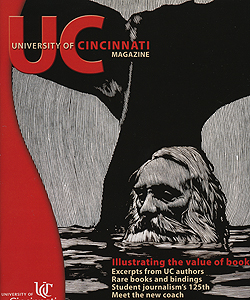 May 2006
May 2006
Illustrating the Value of Books
 Past Issues
Past IssuesBrowse our archive of UC Magazine past issues.
The University of Cincinnati's new Campus Recreation Center, the final piece of the dynamic MainStreet initiative, is receiving outstanding reviews from national architecture critics.
The building's anchor, a premier fitness club for students, employees, alumni and the public, opened in February and includes swimming pools, a current channel, a climbing wall, a six-court gym and more than 200 cardio and strength machines. The 350,000-square-foot building, created by Pritzker Prize winner Thom Mayne, also includes housing, dining, classrooms and a convenience store. Accolades follow:
"Every once in a while a building comes along that fulfills your faith that architecture can be a noble profession, not just a parade of street-walking 'starchitects' who strut their signature styles around the globe. The new Student Recreation Center deserves such praise." --The Chicago Tribune
"Especially as viewed from the running track, it is amongst the most dramatically impressive interior spaces produced by any firm in the last decade. Architecture students will be studying images of it 30 years from now. Together with existing buildings by Frank Gehry, Michael Graves, Peter Eisenman and others, MainStreet gives the university one of the most impressive collections of contemporary architecture on any American campus." --The Los Angeles Times
MainStreet received additional praise from the American Institute of Architects, which named MainStreet's Joseph Steger Student Life Center among the world's 11 best buildings of 2006.
Judge for yourself during the MainStreet celebration scheduled for May 19 and 20. Event information and a photo tour of the Campus Recreation Center are available online.
Hunger hormone -- Scientists from the University of Cincinnati's Obesity Research Center found that ghrelin, a hormone normally associated with food intake, may also impact memory loss from aging and Alzheimer's disease. UC's Stephen Benoit and Matthias Tschop co-authored the Yale-led study that indicates the "hunger hormone" might also boost memory performance.
Brain damage -- A chemical commonly used in food containers may damage the developing brain. According to a research team headed by Scott Belcher from UC's pharmacology and cell biophysics department, low doses of bisphenol A, a chemical widely used in food cans and milk container linings could disrupt the beneficial effects of estrogen on a child's brain growth and viability.
Prostate cancer -- UC oncologist Leslie Oleksowicz is leading a national study for a potential vaccine to fight advanced prostate cancer. VITAL-1 would stimulate the immune system for patients whose disease has spread and stopped responding to hormone therapy. Clinical trials suggest the vaccine could be a more beneficial, less toxic alternative to chemotherapy.
Robotic surgery -- If two heads are better than one, four arms must be ideal, particularly when it comes to robotic surgery. UC's Calvin Selwyn performed gastric bypass surgery in December using a da Vinci robotic surgical system with four arms, each controlling instruments inside a tiny hole in the abdomen. In the past, doctors, working from an interactive console, used a three-arm robot: one to hold the camera and two to perform surgery. In this case, believed to be only the second four-armed procedure in the world, Selwyn was able to "virtually" operate with greater precision while suturing.
Stroke recovery -- UC doctors Joseph Broderick and Thomas Tomsick found in a recent study that medication alone is insufficient to quickly reopen clogged arteries following a stroke. The investigators, who attracted more than $17 million in funding for the next phase of the study, discovered that clot-busting medication should be combined with low-energy ultrasound to clear arteries and reduce chances of brain damage.
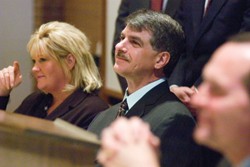
Melinda and Clarence Elkins thank UC students for freeing him from jail for a crime he didn't commit. photo/Dottie Stover
For seven and a half years, Clarence Elkins sat behind bars for a horrendous crime he knew he didn't commit -- the brutal rape and murder of his mother- in-law, as well as the beating and rape of his 6-year-old niece. At home in Akron, Ohio, his wife, spurned by her family, never gave up on him. But she nearly gave up on the American justice system, until UC College of Law students intervened in the spring of '04.
Thanks to the University of Cincinnati-based Ohio Innocence Project, Elkins walked out of the Mansfield Correctional Institution right before Christmas as a free man -- the group's first exoneration since it began in May '03.
At first, the students tried to get Elkins a new trial by submitting DNA evidence that excluded him from the crime scene. When that failed, they submitted DNA evidence that Elkins had personally obtained, linking a man on his cellblock to both victims.
The local judge and prosecutor's office were not wavering until Ohio attorney general Jim Petro intervened on behalf of the frustrated students. That led to Elkins' convictions for rape and murder being overturned.
In February, Elkins, his wife and Petro came to campus to praise the untiring efforts of the 20 UC students and their director Mark Godsey, an associate professor. "I'm not much on words," Elkins told a packed lecture hall at the College of Law, "but I speak from the heart.
"I just want to say thanks to everyone here. I want to encourage you all to keep up what you're doing. You change people's lives. You did mine."
Link:
Read more about the Ohio Innocence Project at UC
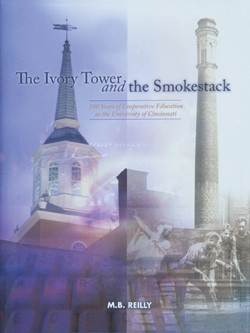
The cooperative education story -- from its tenuous start in 1906 by University of Cincinnati engineering dean Herman Schneider to its adoption by universities around the world -- is told in a newly published book, "The Ivory Tower and the Smokestack." Major funding for the book that celebrates the centennial came from the Herman Schneider Memorial Fund.
The book is "a photo-rich compilation of stories that brings to light some wonderfully unexpected, intriguing and perhaps overlooked episodes in co-op's 100-year heritage," says author M.B. Reilly, UC public information officer. "The book doesn't look at co-op as an abstract principle or disembodied concept. ... (It) is a tale of trust fulfilled and retold in the form of one-to-one accounts of young lives changed, enhanced by experience."
Copies of "The Ivory Tower and the Smokestack" are available at the UC Bookstores and online.
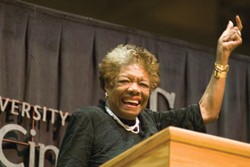
Maya Angelou greets UC admirers. photo/Dottie Stover
One of the great voices of contemporary African-American literature, world-renowned poet Maya Angelou urged students to make room in their lives for poetry and romance, asked them to get to know the great African-American poets and called the University of Cincinnati "a rainbow in the clouds."
Speaking as part of the UC Leadership Lecture Series in February, Angelou addressed an enthusiastic crowd of 5,500 at the university's basketball arena. Though some had waited as long as two hours in the cold before the doors were opened, all rose to a standing ovation when she appeared.
"God put the rainbow in the clouds," said the author of 12 best-selling books, "which means in the worst of times, in the meanest of times, in the most threatening of times the viewer can see light, a ray of hope. UC is a rainbow in the clouds. Once you leave this place and are prepared for the world, you will see."
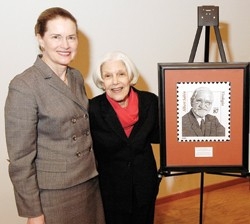
Albert Sabin, HonDoc '74, the UC virologist who developed a live-virus oral polio vaccine in the 1950s, is pictured on a new 87-cent first-class U.S. stamp, part of a series honoring distinguished Americans. It was introduced March 8 at a ceremony on the University of Cincinnati's medical campus.
Sabin, who died in 1993, was on staff at the UC College of Medicine when he developed his vaccine against the crippling childhood disease. After worldwide trials, it was approved for use in the U.S. in 1960. One of the most esteemed scientists in the world, Sabin received the National Medal of Science and the Presidential Medal of Freedom.
When introducing the new stamp, Cincinnati postal officials gave framed enlarged images to Heloisa Sabin, the doctor's widow [pictured above, on right, with health affairs provost Jane Henney] and to UC. The university's image is on display near the permanent Sabin exhibit at the Vontz Center for Molecular Studies, Eden Avenue and Martin Luther King Drive.
Though cystic fibrosis was once thought unbeatable, Dan Hassett may have discovered a cure for the lung-clogging sticky mucous that spells a death sentence for tens of thousands of CF patients. The University of Cincinnati scientist says he has discovered the "Achilles' heel" of the dangerous organism that goops up airways.
Hassett found that the deadly bacterium that haunts CF patients is vulnerable to sodium nitrate, a common chemical used to cure meat. "We can essentially say that this organism, which some people thought could never be beaten, can now be destroyed by nothing more exotic than a common food preservative," he says.
Cystic fibrosis, which affects about 30,000 people in the United States, is an inherited disease caused by a genetic defect. Most with the disease live an average of 35 years.
"White cells from our immune system try to get in there to fight off the invaders," Hassett says, "but they can't reach the bacteria to kill them because they're enmeshed in that thick mucous, essentially a human form of quicksand."
Hassett and a 15-member research team from the U.S. and Canada found that slightly acidified sodium nitrate is able to penetrate the antibiotic-resistant organism. The next hurdle will be bringing the treatment to the bedside as it may potentially have toxic side effects.
The university has entered into a deal with Cincinnati Bell designed to cut the cords to landline phones and data ports and take the University of Cincinnati's Uptown Campus entirely wireless.
By fall quarter, the new marketing agreement will offer students and employees Bearcat phones with new features, guaranteed three-bar coverage and cheaper bills. Selling points include unlimited local minutes, five-digit dialing for campus extensions, unified messaging and even a mobile help button. Technicians are also adding at least 50 new wireless Internet access points across campus.
Administrators intend to eventually blanket campus with data-capable "smart phones" that will allow users to access university Web portals to check grades, get directions on campus or even listen to their e-mail. The goal is to be the trendsetter and make UC a place where dorms and offices no longer rely on landlines and data services.
"I was brought here seven years ago to create a wired campus," says Fred Siff, UC vice president and chief information officer, "and now we are in the process of unwiring it."
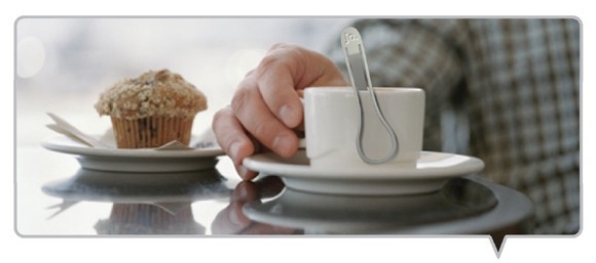
The telephone rings just as you are about to enjoy a hot cup of tea or coffee. When you return, the beverage is cold. Geoff Baldwin, a University of Cincinnati industrial design senior, has a quick, non-electric solution: a heater-spoon. It clips to the side of a cup and gives off a burst of heat when pressure is applied as the liquid is stirred.
His idea earned Baldwin a $1,700 prize and opportunities to network with International Housewares Association professionals and other student winners on a free trip to Chicago in March. His spoon-shaped "Jo Smart beverage heater" was on exhibit at the association's annual international show.
"I went into the show with no expectations," he says, "other than it was an opportunity to meet other industrial designers and I was representing my school. It's possible that I may hear from three companies who showed interest: Campbell's, Starbucks and Kroger."
The design student, who co-oped last year with Studio Red (an innovation company in New York), might appear on television this summer. Documentary teams from HGTV and MSN interviewed him at the Chicago show.
Carlo Montemagno, former chair of the UCLA Department of Bioengineering, is the new dean of the University of Cincinnati's College of Engineering. Montemagno held joint appointments at UCLA in mechanical and aerospace engineering, and has a BS in agricultural and biological engineering, an MS in petroleum and natural gas engineering and a PhD in civil engineering and geological sciences. Because of his scholarly record, he has been deputy director of the California Nanosystems Institute, co-director of the NASA Center for Cell Mi-metic Space Exploration and a fellow of the American Academy of Nanomedi-cine.
In addition, Governor Bob Taft appointed two new members to the UC Board of Trustees:
C. Francis Barrett, JD '71, is president and a founding member of the Cincinnati law firm Barrett & Weber. He also serves on boards for Mercy Health Partners Foundation, the Convalescent Hospital for Children and the Ohio Building Authority. He replaces retiring board member George Schaefer.
Margaret Buchanan, Bus '80, MBA '82, is president and publisher of the Cincinnati Enquirer. She serves on the boards of the Fine Arts Fund and the Cincinnati Center City Development Corp., and is a member of the Women's Leadership Collaborative. She replaces Candace Kendle, who resigned.